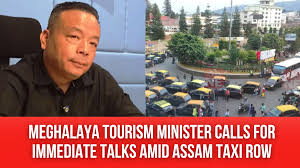Tourist Taxi Dispute in Meghalaya Sparks Calls for Dialogue
A recent dispute in Meghalaya involving the All Khasi Meghalaya Tourist Taxi Association (AKMTA) protesting the presence of taxi services from outside the state has raised concerns about possible retaliation from neighboring Assam. The Meghalaya Tourism Minister Paul Lyngdoh has emphasized the need for open dialogue to resolve these transport-related grievances, warning that unilateral restrictions could harm tourism in both states. This unrest poses risks during peak travel seasons, affecting the flow of tourists and local livelihoods alike.
Concerns Over Retaliatory Measures Against Tourist Mobility
Minister Lyngdoh highlighted that if Meghalaya’s tourist taxis restrict vehicles from Assam, the neighboring state might respond similarly, potentially triggering a transport standoff. Both regions share strong cultural and economic ties, making seamless connectivity essential. The minister advocated for peaceful discussions to avoid disruptions that could dampen regional tourism and reduce income derived from visitors.
Government Efforts and Stakeholder Engagement
The Meghalaya government has established a committee, led by senior official Cyril Diengdoh, to address such transportation disputes. Although periodic meetings have occurred, the impasse continues, leading to frustration among the stakeholders. Minister Lyngdoh called on the AKMTA and their Assam counterparts to settle differences through talks rather than protests, which could escalate tensions and complicate inter-state cooperation.
Understanding the Broader Context of Meghalaya’s Tourism and Transport Relations
Meghalaya, a picturesque state in northeastern India, is known for its natural beauty and vibrant tribal culture. Its tourism sector relies heavily on accessibility and cooperative transport arrangements. The state’s rugged terrain lacks rail connectivity and depends largely on road networks connecting it to Assam and other neighbors. This dependence makes taxi services crucial for visitors exploring landmarks, natural parks, and cultural festivals in the region.
Meghalaya’s Tourism and Transport Infrastructure
Although Shillong, the capital, is the largest urban center, many tourist destinations lie in remote hilly districts where transport options are limited. The flow of tourists is supported primarily by taxi operators and local transport providers, who connect visitors to popular sites in the Khasi, Garo, and Jaintia hills. Disputes in taxi services can, therefore, significantly disrupt the ease and enjoyment of travel.
Table: Key Tourist Transport Challenges in Meghalaya
| Challenge | Impact on Tourism | Recommended Solution |
|---|---|---|
| Inter-state taxi service restrictions | Reduced mobility, visitor inconvenience | Dialogue between taxi associations and government |
| Limited transport infrastructure | Difficult access to remote attractions | Investment in road networks and regulated transport |
| Uncoordinated local policies | Confusion and operational conflicts | Consistent state-level transport frameworks |
Historical Background on Meghalaya and Inter-State Relations
Meghalaya became a separate state in 1972, carved out from Assam, with a distinct demographic largely composed of indigenous tribal communities such as the Khasis, Garos, and Jaintias. Historically, these groups have preserved unique cultural identities and languages. The state’s mountainous geography has contributed to relative isolation but also to its scenic allure, drawing tourists attracted to its cloud-covered hills, forests, and waterfalls.
The connection between Meghalaya and Assam remains vital due to geographic contiguity and shared economic interactions. Transport and trade routes between the two remain essential for local populations and the tourism sector. Past disputes over transport have occasionally flared but typically are resolved through governmental mediation processes.
Implications for the Tourism Industry and Regional Cooperation
Tourism thrives on accessibility, cooperation, and the seamless movement of visitors. In regions like Meghalaya, where natural landscapes draw tourists seeking adventure, local culture, and pristine environments, disruptions in tourist transport affect more than just convenience—they impact the entire ecosystem of tourism services including lodging, dining, and recreational activities.
Transport conflicts create uncertainty and may deter visitors from planning trips during disputed times, reducing economic benefits for the region. Moreover, strained relations between taxi associations could ripple across other sectors, reducing overall hospitality quality and potentially encouraging visitors to switch to other destinations with more reliable transport options.
Looking Ahead: The Role of Dialogue and Sustainable Transport Solutions
Resolving the taxi dispute through dialogue aligns with sustainable tourism practices that emphasize cooperation and integrated regional development. Shared interests between Meghalaya and Assam in maintaining a steady influx of visitors could foster more robust partnerships among transport providers, local governments, and tourism bodies.
Expanding infrastructure, regulating cross-border taxi operations fairly, and investing in modern transport alternatives like eco-friendly vehicles could enhance visitor experience and local livelihoods. Encouraging the formation of joint committees to oversee inter-state mobility would safeguard tourists’ ease of travel and harmonize services across borders.
Conclusion: Navigating the Path Forward for Meghalaya’s Tourism
The ongoing tourist taxi dispute in Meghalaya underscores the delicate balance required in managing inter-state transport within a thriving tourism environment. With Meghalaya’s rich natural beauty and cultural heritage drawing visitors, it is crucial that transport networks remain open, cooperative, and efficient.
Active dialogue and mutual understanding among all stakeholders—taxi associations, government officials, and the tourism sector—are essential to prevent conflicts escalating into disruptive actions. This approach ensures that tourists have reliable access to one of northeastern India’s most captivating destinations.
For travelers considering chartering a yacht or renting a sailing boat to explore coastal or inland water destinations in India and beyond, awareness of transport dynamics in regions like Meghalaya highlights the importance of planning and communication when arranging local transfers. Services that coordinate with local transport providers can offer greater convenience for visitors wishing to explore both land and water sights seamlessly.
To explore further on destinations, yacht charters, sailing adventures, and boat rentals worldwide, GetBoat.com is an international marketplace for renting sailing boats and yachts, offering options to suit every taste and budget across marine resorts and inland water locations globally.

 Dialogue Urged to Resolve Meghalaya Tourist Taxi Conflict and Protect Regional Tourism">
Dialogue Urged to Resolve Meghalaya Tourist Taxi Conflict and Protect Regional Tourism">
